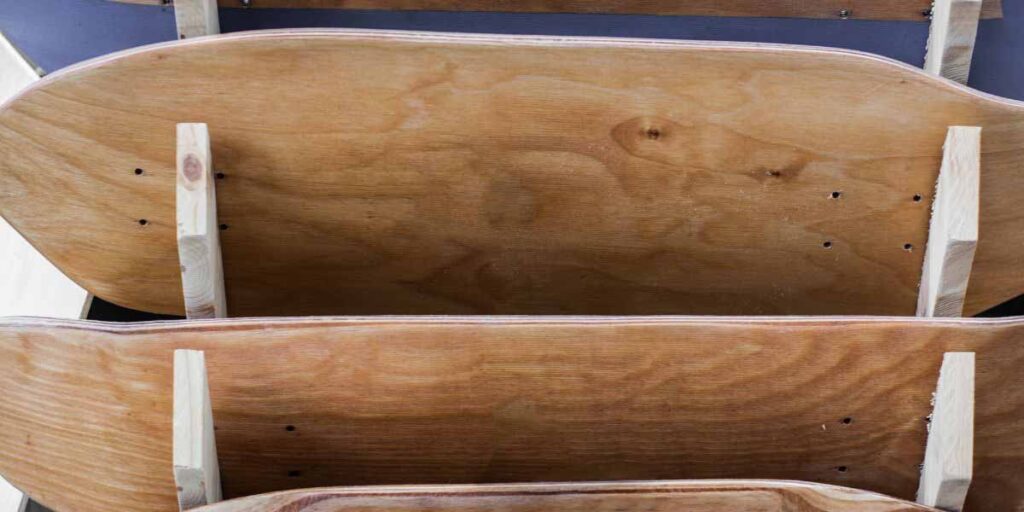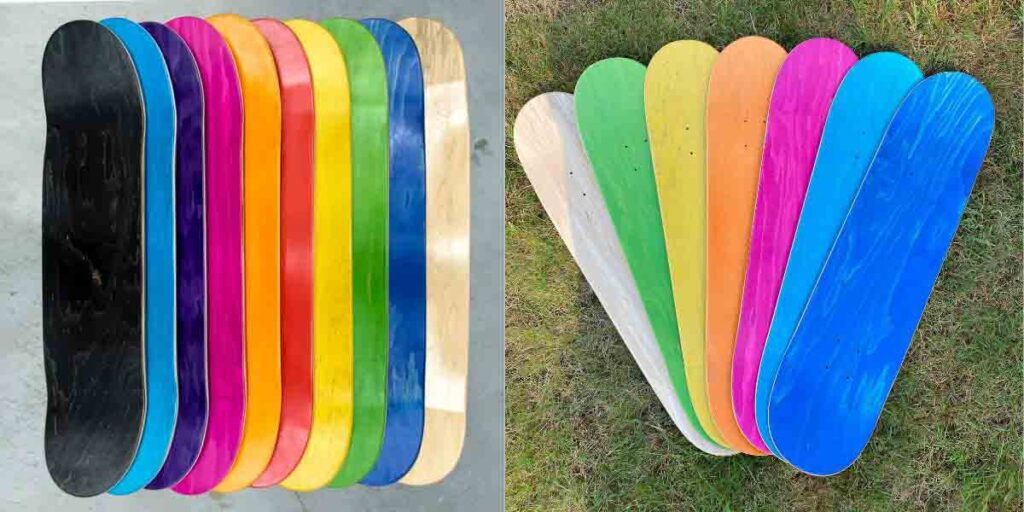Skateboard decks are primarily made from various materials like maple wood, bamboo, carbon fiber, fiberglass, and plastic.
Each material affects the skateboard’s performance, weight, and durability in different ways. Knowing what skateboard decks are made of can help you choose the right deck for your skating style. Whether you’re cruising, performing tricks, or hitting the skatepark, the material of your skateboard deck plays a crucial role in how your board performs.
Looking for the best skateboard deck material? Read on to find out what each option offers and how to choose the right one for your needs!
Skateboard Deck Materials
Types of Skateboard Deck Wood:
Maple Wood
Maple wood is the go-to choice for many skateboard decks. It’s known for its strength and durability. Maple decks are usually made from 7 to 9 layers (plies) of thin maple veneers glued and pressed together. This construction provides the stiffness needed for tricks and the flexibility required for a smooth ride. As a result, maple wood decks are ideal for street and park skating because they can withstand high impacts.
Canadian hard maple, often used in decks, is prized for its tight grain and resilience. The 7-ply maple construction, bonded with epoxy resin, offers a balance between stiffness and flexibility, enhancing the deck’s “pop” and longevity
Bamboo
Bamboo decks are a more recent addition to the skateboarding world. They are lightweight and flexible, making them a great choice for cruisers and longboards. Bamboo is also considered an eco-friendly option since it grows faster than trees and is more sustainable to harvest. Bamboo decks offer a softer, more bouncy feel compared to maple.
Bamboo’s natural flexibility allows for smoother rides, effectively absorbing vibrations. Some manufacturers combine bamboo with fiberglass layers to enhance strength without compromising its lightweight nature.
Other Woods
Occasionally, skateboard decks are made from other woods like birch or ash. These are less common but can offer different flex and feel.
Birch wood is sometimes used as a more affordable alternative to maple. Although it’s not as strong or durable as maple, birch still offers a decent amount of flex. It can also be a good choice for budget-conscious skaters or those just starting.
Ash wood is another alternative, known for its shock-absorbing properties. It can be beneficial for absorbing impacts from jumps or rough terrain. However, it’s heavier and less flexible than maple, which is why it’s not as commonly used in standard skateboard decks.
Walnut is occasionally used in hybrid decks, where it’s combined with other materials like maple or carbon fiber. Walnut adds a unique aesthetic appeal and a bit of added durability. Yet, it’s usually more expensive and less flexible, making it a niche choice for custom or high-end boards.
However, they’re generally not as durable as maple, which is why they’re less popular in traditional skateboard decks.

Carbon Fiber
Carbon fiber decks are the top choice for high-performance and ultra-lightweight options. These decks often combine carbon fiber layers with other materials like maple or foam cores. Carbon fiber decks are known for their stiffness and strength, making them perfect for professional skaters.
The integration of carbon fiber enhances the deck’s tensile strength, providing a responsive feel and reducing the risk of breakage during high-impact tricks.
Plastic Decks
Plastic decks, often seen in cruisers and mini boards like Penny boards, are lightweight and water-resistant. They are great for casual riding and commuting but don’t offer the same performance as wooden or carbon fiber decks.
While plastic decks are durable and weather-resistant, they often lack the grip and responsiveness required for advanced maneuvers, making them more suitable for beginners or casual riders.
Fiberglass
Fiberglass decks usually involve a composite construction, where layers of fiberglass are sandwiched between other materials like wood or carbon fiber. Fiberglass adds strength and durability to the deck without significantly increasing weight.
Fiberglass layers enhance the deck’s structural integrity, providing resistance against warping and delamination, especially in varying environmental conditions.
Aluminum
Aluminum decks are another alternative, though they are less common. Aluminum decks offer extreme durability and are nearly indestructible under normal use. They are also water-resistant and perform well in wet conditions. However, aluminum decks tend to be heavier than wood or composite decks. This extra weight can make them less appealing to skaters who prefer lightweight setups.
Hybrid Materials & Composite Decks
Some high-performance skateboard decks are made using hybrid construction, combining multiple materials for enhanced performance. These composite decks often layer maple wood with carbon fiber, fiberglass, or foam cores.
The idea is to retain the natural pop and flexibility of maple while adding the strength and durability of carbon fiber or fiberglass. This kind of construction reduces weight without sacrificing performance, making it ideal for advanced skaters who demand both a lightweight feel and long-lasting pop.
These hybrid decks are popular among professionals and serious amateurs alike. While they tend to cost more, they deliver better shock absorption, resistance to wear, and a crisper pop over time.
Importance of Deck Material
The material of your skateboard deck plays an important role in how your board performs. It affects everything from how the board feels under your feet to how well it handles tricks. The right material can make a difference in weight, flexibility, and durability. Skateboarders need a deck that matches their style and skill level.
Advanced deck constructions, such as Impact Support technology, incorporate carbon fiber discs at stress points to enhance durability and impact resistance, catering to skaters who frequently perform high-impact tricks.
How Are Skateboard Decks Made? Step-by-Step Guide

The process of making skateboard decks varies slightly depending on the material but generally involves a few key steps:
- Layering: For wooden decks, thin layers of wood veneer (usually maple) are glued together in a cross-grain pattern to add strength.
- Pressing: The layered veneers are pressed into a mold that gives the deck its shape and concave. This step is crucial for creating the pop and feel of the skateboard.
- Shaping and Cutting: After pressing, the decks are cut to their final shape using templates and machinery. The nose, tail, and sides are smoothed, and holes for the trucks are drilled.
- Finishing: Finally, the decks are sanded, sealed, and painted or printed with graphics.
Some manufacturers utilize cold-pressing techniques to maintain consistent pressure during the curing process, ensuring uniformity in deck flex and strength.
Pros and Cons of Different Deck Materials
Here’s a table of the pros and cons of different skateboard deck materials:
| Material | Pros | Cons |
| Maple | – Durable and strong – Ideal for tricks and street skating | – Heavier compared to other materials |
| Bamboo | – Lighter- Flexible – Eco-friendly – Great for cruising | – Less durable for heavy tricks |
| Carbon Fiber | – Extremely lightweight – Stiff – Great for performance | – Expensive |
| Wood (Traditional) | – Traditional feel – Balance of flex and rigidity – Affordable | – Heavier than some modern materials |
| Plastic | – Lightweight – Durable in casual settings – Resistant to weather | – Not suitable for high – Impact skating or advanced tricks |
How to Choose the Right Skateboard Deck Material
When selecting a skateboard deck, consider your skating style, skill level, and budget:
- For Beginners: Maple decks are a solid choice because they’re durable and provide a good balance of strength and flexibility.
- For Cruisers: Bamboo or plastic decks are excellent for commuting and casual riding due to their lightweight nature.
- For Advanced Skaters: If performance is key, investing in a carbon fiber deck could be worth it for the reduced weight and increased strength.
- On a Budget: A Standard maple or a lower-cost plastic deck can be a great starting point.
No matter your level or style, choosing the right skateboard deck material can greatly impact your overall skating experience. Consider your needs and preferences, and don’t hesitate to try different materials to find what feels best for you. Remember, the perfect deck suits your unique skating journey.
FAQs
What are skateboard decks made of and why does it matter?
Skateboard decks are made from various materials like maple, bamboo, carbon fiber, and plastic. The choice of material affects the board’s performance, weight, and feel. So, it’s important to pick one that suits your style.
Are bamboo decks more sustainable than maple decks?
Yes, bamboo is a sustainable choice because it grows quickly and regenerates without replanting. Bamboo decks are lightweight and flexible, making them popular among eco-friendly skaters.
How does deck material affect the overall skateboarding experience?
Deck material can influence the board’s weight, flexibility, durability, and performance. A heavier maple deck provides stability for tricks. On the other hand, lighter materials like bamboo and carbon fiber offer a more responsive ride.
What is the best material for a skateboard deck?
Canadian maple is the best all-around material for skateboard decks. It’s durable, strong, and great for tricks. For a lighter or eco-friendly option, go with bamboo. If you want high performance, carbon fiber or hybrid decks are top-tier but more expensive.
Are wood or plastic skateboards better?
Wood decks, especially maple, are better for tricks, durability, and overall performance. Plastic decks are lighter and water-resistant, ideal for cruising short distances. If you’re serious about skateboarding, wood is the better choice.
Conclusion
Choosing the right skateboard deck material can improve your performance and overall skating experience. Maple remains the gold standard for durability and pop, while bamboo is great for eco-conscious riders who prefer flex and carving. Carbon fiber and fiberglass are best for high-performance needs, and plastic or aluminum are better suited for cruisers and beginners.
Always consider your riding style, budget, and preferences when choosing your deck. The right deck material will help you skate safer, smoother, and with more confidence.

